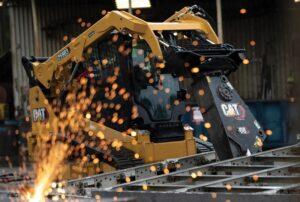Caterpillar has played a role in some of the most renowned films in cinematic history, including “Aliens” and the “Transformers” series. Additionally, the company contributed to the construction of an iconic American landmark: the renowned Hollywood sign.
Lee Fosburgh, the Heritage Services Manager at Caterpillar, supervises a diverse range of historical documents, photographs, antique machinery, and other artifacts associated with the company’s legacy.
“We possess an extensive collection,” Fosburgh remarked, “housed within a 13,000-square-foot facility. The sheer volume amounts to approximately eight football fields’ worth of paper records. Beyond that, we house a range of artifacts, including an antique Caterpillar machine compilation, as well as a vast repository of over a million photographs. Essentially, it encapsulates the entirety of Caterpillar’s history…”
According to Fosburgh, Caterpillar’s origins trace back to the merger of two distinct entities: Holt Manufacturing Company and C.L. Best Tractor Co. He also oversees the archival records of these firms, along with any other enterprises assimilated into the Caterpillar fold.
Caterpillar equipment has featured prominently in some of the most iconic films and franchises ever created. Notably, Cat machines even made a notable appearance in a James Bond movie.
“Arguably one of the most extraordinary instances we’ve encountered,” Fosburgh recounted, “… was in the James Bond film ‘Skyfall.’ In a pivotal chase sequence, a hydraulic excavator was mounted atop a moving train, engaging in dynamic movement. We had the actual excavator from the movie in our collection for a period. However, Caterpillar took a step to make it accessible to a broader audience by donating it to the Ian Fleming Foundation.”
An exceedingly recognizable instance of Caterpillar machinery being employed occurs in the 1986 sequel, “Aliens,” wherein Sigourney Weaver’s character, Ripley, dons the power loader suit to engage in a confrontation with the eponymous alien.

Although the cinematic use of the robotic suit is a product of imagination, the individuals responsible for crafting the suit for its on-screen appearance were deliberate in their choice to feature a well-known brand on the suit.
“They designed this suit which the actors wore in the movies, and interestingly, they chose to incorporate our logo onto the suit,” Fosburgh explained. “It wasn’t necessarily about promoting a specific product, but rather the logo itself. They perceived Cat as an innovative and robust company – a symbol of strength. They believed audiences could identify with that and envision us employing such technology in the future. And that’s how the idea materialized.”
Although the power loader itself isn’t a product offered by Caterpillar, movies sometimes utilize real Cat machinery to demonstrate to customers and audiences the capabilities and strength of their equipment.
“But that’s essentially what ‘Transformers’ was about,” Fosburgh explained. “We were in the process of developing a fresh line, or on the brink of unveiling a new series, of what we term hydraulic excavators … and this concept served as inspiration for digitally creating those transformers. It served as a means to communicate that information and introduce the concept of new excavators to a wider audience.”
Caterpillar was also engaged in the construction of one of the most iconic landmarks closely linked with the film industry: the Hollywood sign.
“C.L. Best Tractor Co. manufactured a tractor known as the Best 60,” Fosburgh recounted. “Following the merger, it was rebranded as the Caterpillar 60. … It was somewhat like the iPhone of the tractor industry at that time. … As they brought the letters up for constructing the sign, they utilized Best tractors from various job sites. These tractors were essentially deployed to transport and position the letters, aiding in the assembly of the Hollywood sign.”




